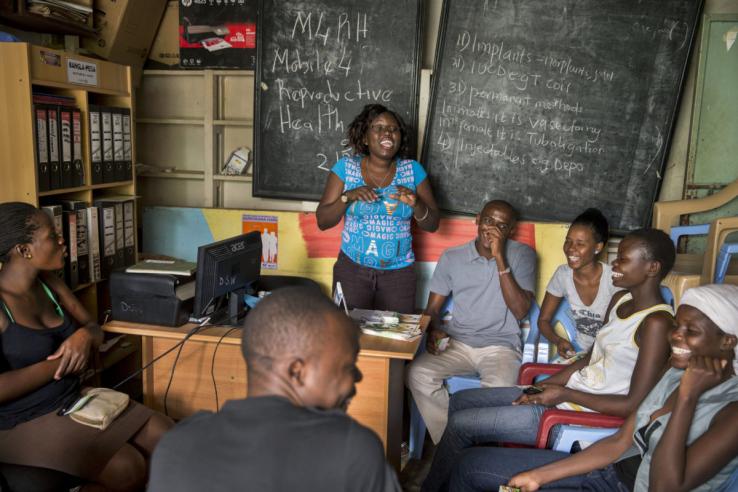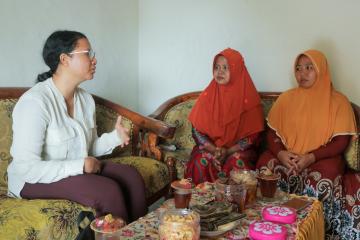
32 years of 16 Days of Activism against Gender-Based Violence: An Evidence-Based Call to UNITE!

This piece is also available on the website of Innovations for Poverty Action (IPA).
In the fight against gender-based violence (GBV) and intimate-partner violence (IPV), which disproportionately affect women and girls, involving men in the violence prevention may be the key to the puzzle. Many of the conventional approaches to addressing GBV and IPV have been through programs that empower women and girls—leaving men out of the equation. As we mark the 32nd anniversary of the 16 Days of Activism against Gender-Based Violence, this year’s theme, ‘UNITE! Invest to prevent violence against women and girls,’ is an open call to everyone, including men and boys, to be an ally in preventing violence against women and girls.
Promising Evidence on Engaging Male Counterparts to Address GBV and IPV
There is a growing body of evidence that shows working with male allies can help prevent GBV, including IPV. Innovations for Poverty Action (IPA) and the Abdul Latif Jameel Poverty Action Lab (J-PAL) have supported rigorous research studies exploring diverse solutions to address GBV and IPV, moving toward a world with less violence toward women and girls.
One pathway through which programs that target men and boys could improve IPV is by changing their attitudes toward acceptability of violence against women and girls. Targeting adolescent boys to reduce IPV has shown promising results in Tanzania, in part by changing their attitudes toward intimate partner violence. J-PAL affiliated professor Manisha Shah and co-authors evaluated a program that offered adolescent girls a goal-setting activity around their sexual and reproductive health, as well as a component that offered their adolescent male romantic partners a soccer-based pedagogy program. Both components were built on top of an ongoing adolescent girls’ empowerment program. The boys' sports program focused on reshaping attitudes and behaviors around: masculinity, IPV, and sexual relationships. The boys' sports program reduced adolescent girls' experience of IPV by 0.2 standard deviations, which was similar in magnitude to the impact of the girls’ goal-setting intervention. The impacts of the sports program were driven in part by changing boys’ attitudes towards the acceptability of IPV, as well as reductions in sexual activity. Adolescents may be a particularly effective age group to target for attitudes change programs, as they may have more malleable attitudes toward gender roles and norms.
Programming that includes male participation to reduce IPV can take different forms. In Uganda, IPA evaluated the Becoming One program, a faith-based couples’ counseling program which yielded a 12 percent reduction in IPV, shifted power from men to women, and improved the overall quality of the relationship for both partners one year after implementation. In the course of twelve in-person group sessions, both women and men were given counseling focusing on improving couples’ relationships rather than on violence. The themes covered included communication, emotional regulation, shared control over finances, sexual consent, and pleasure. Given the promising findings of the evaluation, IPA has identified the program as one of the fourteen innovations featured on ‘Best Bets: Emerging Opportunities for Impact at Scale’—aiming at giving men and women the right tools and knowledge to reduce and prevent IPV—improving their quality of lives.
Similarly, an evaluation in India of a sexual harassment training program delivered by the NGO Safecity also shows how engagement of male teens and young adults can have an important impact on IPV. In partnership with city colleges, the intervention was delivered to men and women in a class-based college setting and focused on building awareness and empathy. Researchers found that when men received the training, women were less likely to report sexual harassment from men in their class. Future research could continue to explore different settings when engaging boys and men to shift GBV attitudes and behavior.
UNITE! by investing in male counterpart engagement research
The frequency and intensity of programs may also be important for future research to explore. Given that attitudes and gender norms often take a long time to change, open questions related to the right mix of interventions remain. Given the complexities, GBV and IPV prevention programs involving men and boys should be tailored to the context and informed by evidence to maximize the impact, minimize backlash, and increase positive outcomes for women, girls, and society.
As we reflect on the call to UNITE!, it is encouraging to see more actors discussing and lifting up the importance of engaging male counterparts in the efforts to address and shift restrictive gender norms. For example, plenary sessions at the Women Deliver conference this summer focused on male engagement as one of the potential solutions to address gender disparities, including in the realm of unpaid care and domestic work and IPV. Likewise, in the World Bank’s recent draft of the 2024-2030 gender strategy, engaging men and boys is noted as a potential solution to foster gender equality and shift gender attitudes. Yet, it is clear that these potential solutions need to be rigorously evaluated, and we look forward to continuing to support research that can help fill in these gaps.




